- Home
- Countries & Regions
- Latin America
- Ecuador
- Topics & Events
- Counterpart training in Japan
Topics & Events
September 10, 2019
Counterpart training in Japan
"Project for Safe and Resilient Cities for Earthquake and Tsunami Disaster" conducted its third counterpart training in Japan during 13 days of stays from 29th August until 10th September. 12 counterparts including the assistant secretary and the director of capacity building from National Service of Risk and Emergency Management (SNGRE), directors of risk management from their two zonal office, the project counterparts from primary and secondary pilot municipalities and Galapagos special zone participated, and underwent the training on management for risk reduction in Japan against earthquake and Tsunami. This time, the training especially focused on Tsunami evacuation and Agenda for Risk Reduction (ARR), and to attain lessons for implementation of their own ARR.
In the training, the participants received lectures from Prof. Dr. Satoru Nishikawa of Nagoya University and Assistant Prof. Dr. Eric Mas of Tohoku University, learned about planning and various efforts of risk reduction at district, municipal and township levels from Shizuoka Prefecture, Numazu and Yaizu municipalities and Yoshida-cho, and visited many Tsunami-evacuation structures in a wide variety.
Moreover, in Miyaghi Prefecture, where the Great East Japan Earthquake had devastated the town in March 2011, they observed the recovery and rehabilitation of Ishinomaki city and visited Arahama Elementary School which has been preserved as a disaster memorial. In both places, the guiding officials, who themselves have been affected by the Tsunami, told the participants that they wished they could have had increased awareness of the citizens for evacuation before the Earthquake. Their very sincere word made a deep impression on the trainees.
The trainees described about this training: "the importance of taking in disaster risk reduction as a part of land use planning has been reaffirmed;" "I learned the importance of designating responsibilities to and coordinating among the national, district, municipal and citizen's levels." Their proposals for implementation of their ARR presented on the last day of the training reflected such strong wills.
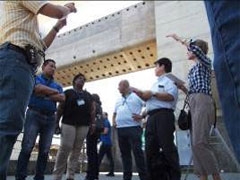 1. Guided by the official of Shizuoka Prefecture, the participants visited a large-scale lock gate "Viewo", which also functions as a sightseeing spot.
1. Guided by the official of Shizuoka Prefecture, the participants visited a large-scale lock gate "Viewo", which also functions as a sightseeing spot.
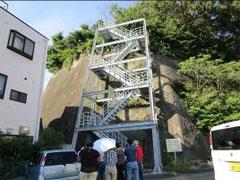 2. The trainees climbed up the evacuation staircases installed on the sidewall of a hill located in a residential area in Numazu, and observed the space available for temporally evacuation.
2. The trainees climbed up the evacuation staircases installed on the sidewall of a hill located in a residential area in Numazu, and observed the space available for temporally evacuation.
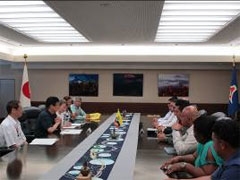 3. The group made a courtesy call to the governor of Shizuoka prefecture, who warmly welcomed them, and Mr. Espinosa, Assistant General of SNGRE expressed their appreciation for providing them with this great opportunity of learning.
3. The group made a courtesy call to the governor of Shizuoka prefecture, who warmly welcomed them, and Mr. Espinosa, Assistant General of SNGRE expressed their appreciation for providing them with this great opportunity of learning.
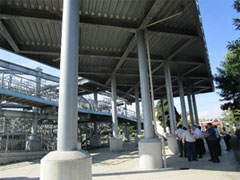 4. During the visit to a Tsunami evacuation tower located in Shimizu ward in Shizuoka city in Shizuoka prefecture, many questions were asked in relation to practical challenges foreseen upon implementation in Ecuador, including its structure, capacity, cost required, and other details.
4. During the visit to a Tsunami evacuation tower located in Shimizu ward in Shizuoka city in Shizuoka prefecture, many questions were asked in relation to practical challenges foreseen upon implementation in Ecuador, including its structure, capacity, cost required, and other details.
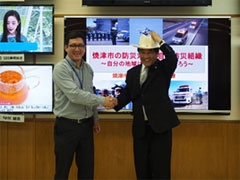 5. Upon the courtesy call to the Mayor of Yaizu municipality, in response to the warm welcome expressed by the Mayor, the Assistant Secretary Mr. Espinosa handed over their souvenirs from Ecuador.
5. Upon the courtesy call to the Mayor of Yaizu municipality, in response to the warm welcome expressed by the Mayor, the Assistant Secretary Mr. Espinosa handed over their souvenirs from Ecuador.
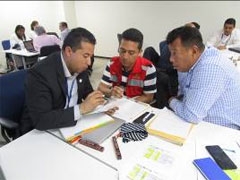 6. On the mid day of the training, the participants exchanged their ideas about how to apply what they had learnt from the training to their formulation and implementation of ARR.
6. On the mid day of the training, the participants exchanged their ideas about how to apply what they had learnt from the training to their formulation and implementation of ARR.
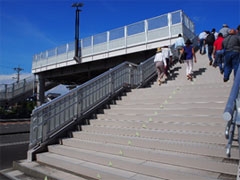 7. Among the 15 Tsunami evacuation towers existing in Yoshida-cho, Shizuoka Pref., the group visited the tower K, which functions as pedestrian overpass in daily life. It had interested the participants very much, for this form of tower would not require the local government to acquire additional land for building it.
7. Among the 15 Tsunami evacuation towers existing in Yoshida-cho, Shizuoka Pref., the group visited the tower K, which functions as pedestrian overpass in daily life. It had interested the participants very much, for this form of tower would not require the local government to acquire additional land for building it.
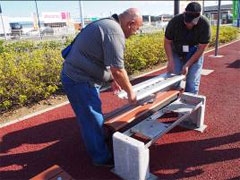 8. In the disaster-prepared park in Yoshida-cho, the participants tried setting up a "portable stove-bench" installed in the park in case of evacuation.
8. In the disaster-prepared park in Yoshida-cho, the participants tried setting up a "portable stove-bench" installed in the park in case of evacuation.
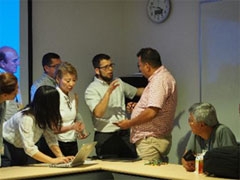 9. After the lecture on Tsunami mechanism and countermeasures delivered in Spanish by Dr. Eric Mass, assistant professor, Tohoku University, the participants asked questions to deepen their understanding of the issue.
9. After the lecture on Tsunami mechanism and countermeasures delivered in Spanish by Dr. Eric Mass, assistant professor, Tohoku University, the participants asked questions to deepen their understanding of the issue.
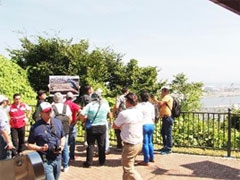 10. From Hiyori-yama, a hill looking down the town of Ishinomaki city which was ocne engulfed with Tsunami, the group observed the rehabilitation works in progress in the bay area protected by tide embankment.
10. From Hiyori-yama, a hill looking down the town of Ishinomaki city which was ocne engulfed with Tsunami, the group observed the rehabilitation works in progress in the bay area protected by tide embankment.
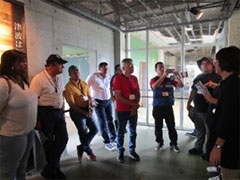 11. At the ruin of Arahama elementary school, the group listened to the local guide and audio-visual exhibition explaining how the wave of Tsunami pushed into the neighborhood and how the residents and students saved themselves from the wave in the school.
11. At the ruin of Arahama elementary school, the group listened to the local guide and audio-visual exhibition explaining how the wave of Tsunami pushed into the neighborhood and how the residents and students saved themselves from the wave in the school.
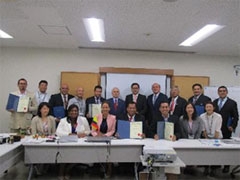 12. To the final reporting and evaluation meeting, Hon. Ambassador of the Republic of Ecuador, Mr. Jaime Barberis (6th from the right in the back row) came and encouraged the group of Ecuadorian counterparts to feedback their learning to their works.
12. To the final reporting and evaluation meeting, Hon. Ambassador of the Republic of Ecuador, Mr. Jaime Barberis (6th from the right in the back row) came and encouraged the group of Ecuadorian counterparts to feedback their learning to their works.
- About JICA
- News & Features
- Countries & Regions
- Our Work
- Thematic Issues
- Types of Assistance
- Partnerships with Other Development Partners
- Climate Change / Environmental and Social Considerations
- Evaluations
- Compliance and Anti-corruption
- Science and Technology Cooperation on Global Issues
- Research
- JICA Development Studies Program / JICA Chair
- Support for the Acceptance of Foreign HRs / Multicultural and Inclusive Community
- Publications
- Investor Relations
